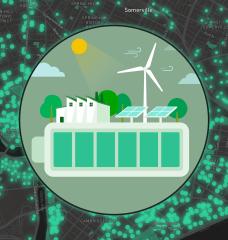
The ongoing demand for power among the South Asian countries, surrounding Central Asian Sub-region, recommends a technically and economically viable cross-border electricity trading. However, it has been difficult to ensure grid connectivity between all the SAARC member countries due to geopolitical complexity and geographic limitation – a country which is noticeably secluded from the rest of the neighboring countries. The isolation of Maldives in cross border power trading was well stipulated on SAARC Regional Energy Trade Study (SRETS). It is self-evident that Maldives falls under the remote zone, a country that consists of numerous pieces of lands along with significant inter-country geographic detachment. Subsequently, in consideration of fulfilling power demand and sustainable economic development, it is worth giving a second thought to the true necessity of inter/intra-country power transmission/trading in Maldives.
Male, the capital city, is 564 km and 728 km away from the closest parts of India and Sri Lanka respectively. There are more than a thousand islands spread out over an area of 865 km from north to south and only 185 of them are inhabited. The Greater Male region (Thilafushi, Gulhifushi, Male, Hulhumale, and Villingili islands) is predominantly active in terms of economic growth, population density, increasing GDP, and tourism sector development. It would be rational to have an intra-power grid connection among these major zones of Male. Technically, it needs a submarine cable interconnection between the islands of the greater Male region. Considering the distance, the expense of submarine cable installation would be higher than a typical overhead transmission line. For submarine cable installation, the cost was estimated to be USD 26.4 million from Male to Hulhumale; USD 10.9 million from Male to Villingilli; and USD 26 million from Villingilli to Thilafushi. These approximated amounts do not include power generation costs. USD 63 million was well estimated from SARI/Energy Maldives-Submarine cable Interconnection – a pre-feasibility study which includes additional power generation in Hulhumale to secure future demand of Hulhumale, Thilafushi, Villigili, and Male (110 MW build up in Hulhumale by 2030) in addition to dual cable as a failsafe.
The unique geographic positioning leads to high-cost power generation and underwater cable technology that raises questions about cost-effectiveness and efficient returns. Every unit increase in tariff will be significant for the inhabitants on each island as population is less than 1,000 on average, which will remain unchanged due to the small size of each island. Hence, power demand will be unchanged, if not low, in greater Male islands. High-cost operation and maintenance would be an additional burden to cover up from charges paid by such static numbers of population in each island. Such causal effects will eventually make revenue generation scanty for both public and private power utilities. If the islands get connected under a solo grid, existing power transmission and distribution (T&D) networks will need to be upgraded in order to avoid network overloading. Such major power T&D line rehabilitation will also amplify currently estimated costs. Such robust complexity (both geographic remoteness and inefficient economic return) elucidates a lesser possibility for the Greater Male region to be connected with neighboring countries (India and Sri Lanka) as well. No doubt, it will be unduly difficult, both technically and financially, to make power trade connection covering an average distance of 546 km from Greater Male to its closest neighboring countries.
From 2008, The State Electric Company Limited (STELCO), state-owned utility organization of Maldives, started expanding services from the North to South of the country accumulating 28 islands, ensuring 60% of the total population of Maldives. STELCO mainly relies on diesel-based power generation and very recently, the Government of Maldives has announced to be carbon neutral by 2020. Overreaching emission of diesel or fossil fuel-based power plants, which could be the inevitable source of power for the national grid system (widespread in neighboring countries), coupled with insufficient land availability, will hinder the growth of carbon-neutral power generation. Maldives National Energy Policy & Strategy 2010 focuses on ensuring that 50% of the electricity supplied is from renewable sources by 2015 (in 2009 the country spent 15% of GDP on fossil fuel imports) (‘Maldives 2012’, 2016). Furthermore, it is difficult to set up conventional fossil fuel-based power plants in congested islands like Male and Hulhumale due to environmental impact and shortage of land.
Maldives, the archipelago has potential sources of renewable energy. Large-scale Solar PV and Onshore wind have been well-addressed by the International Renewable Energy Agency (IRENA). However, the impediments of renewable investment are manifold. It is difficult to manage finance due to the high risk of project complexity. At the same time, the payback period is prolonged for loan financing. Availability of space in the Greater Male region for Solar PV and onshore wind power installation is a crucial factor to cope up with. Some islands are available for large-scale Renewable Energy (RE) installations; however, the evacuation and transmission of power from RE plants/islands are expensive, as discussed before. Thus, also simplifying the fact that Renewable Energy mini-grids are difficult to be considered as well as large scale RE based electrification requiring an interconnected grid, which is too expensive to set up.
Considering all the limitations of multiple energy security options, as discussed, a hybrid system could be a better option for a sustainable energy source. Maldives spent more than USD 470 million on oil imports in 2012. To minimize both cost and emission new island-based hybrid electricity systems (a combination of solar PV and diesel) have been recommended by The Asian Development Bank (ADB). ADB is allocating USD 50 million grant assisting Maldives to enhance renewable energy resources and usage. Such hybrid electricity systems will deliver cleaner & reliable electricity, and reduce the current cost burden. ADB’s piloting initiatives will enable the government-owned utilities to install solar-diesel hybrid grids on nearly 160 islands in four phases (S. Addu, B. Goidhoo, Th. Buruni, Ga. Vilingili, and Lh. Khurendhoo).
It is well understood that as long as the underlying limitations prevail, intra-country power grid or inter-country power trading is beyond reality for Maldives.






